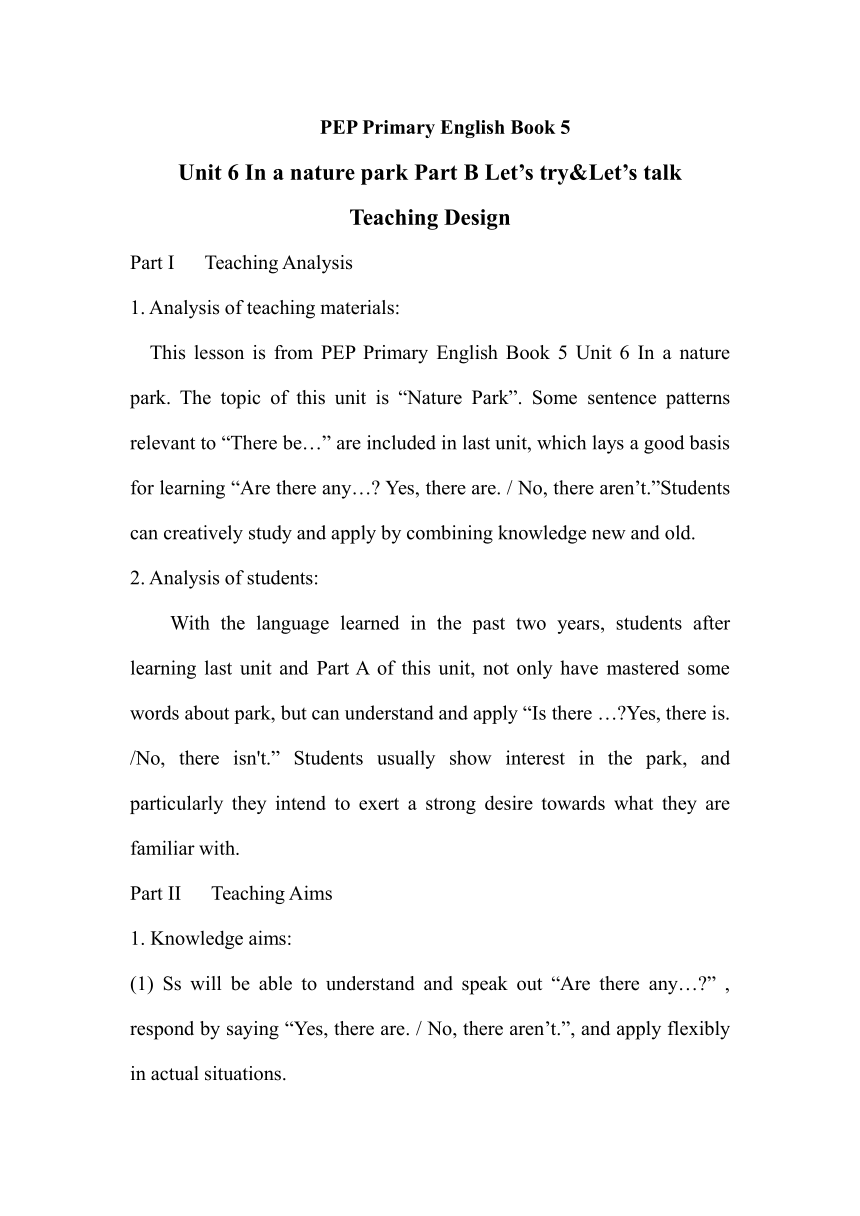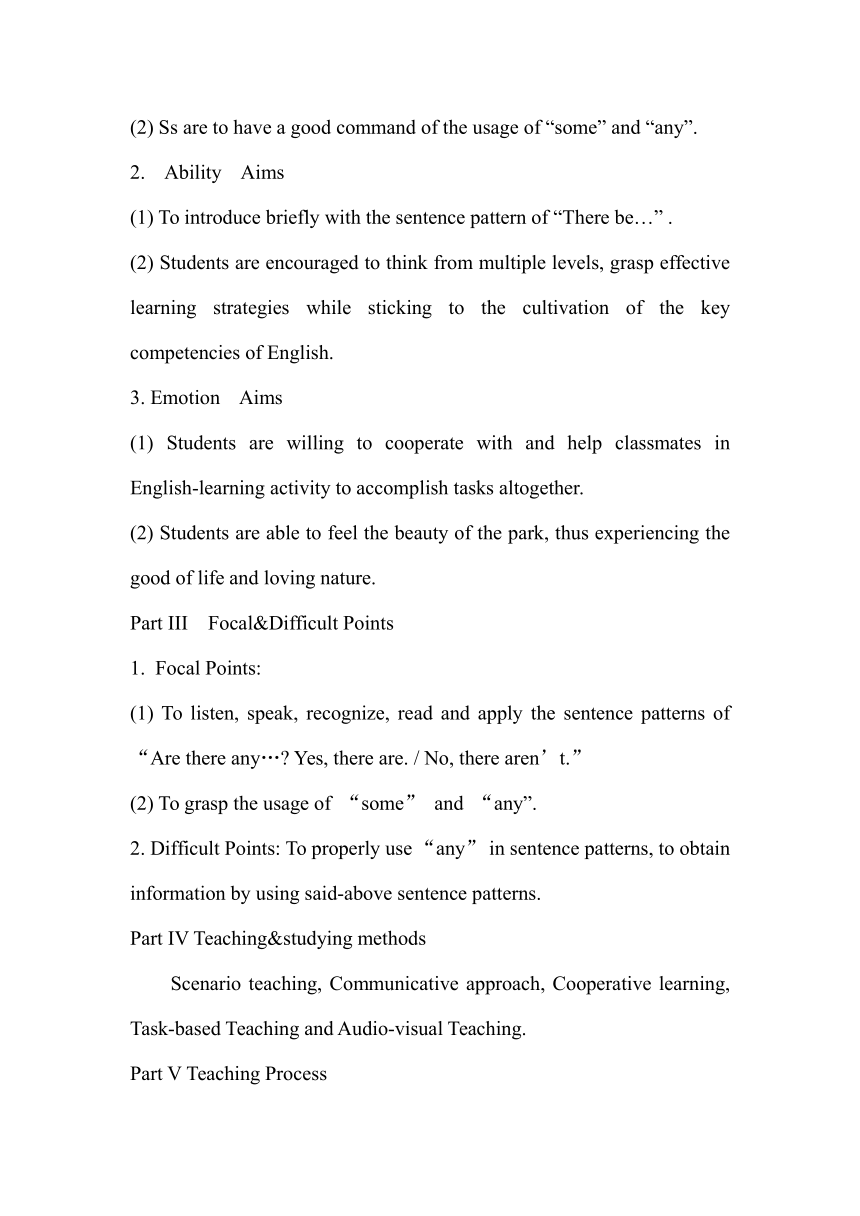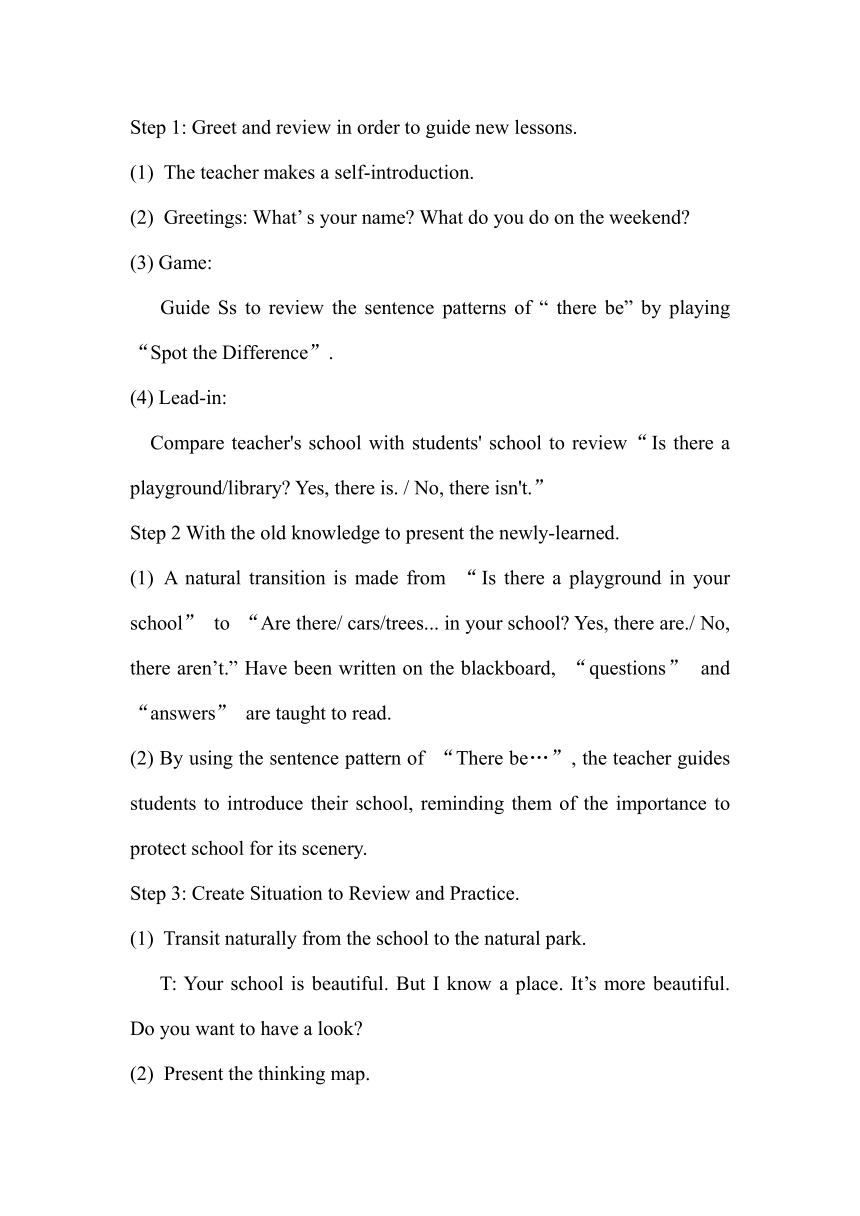Unit 6 In a nature Part B Let’s try&Let’s talk 教案
文档属性
| 名称 | Unit 6 In a nature Part B Let’s try&Let’s talk 教案 |  | |
| 格式 | zip | ||
| 文件大小 | 7.5KB | ||
| 资源类型 | 教案 | ||
| 版本资源 | 人教版(PEP) | ||
| 科目 | 英语 | ||
| 更新时间 | 2019-12-01 11:17:22 | ||
图片预览



文档简介
PEP Primary English Book 5
Unit 6 In a nature park Part B Let’s try&Let’s talk
Teaching Design
Part I Teaching Analysis 1. Analysis of teaching materials:
This lesson is from PEP Primary English Book 5 Unit 6 In a nature park. The topic of this unit is “Nature Park”. Some sentence patterns relevant to “There be…” are included in last unit, which lays a good basis for learning “Are there any…? Yes, there are. / No, there aren’t.”Students can creatively study and apply by combining knowledge new and old.
2. Analysis of students:
With the language learned in the past two years, students after learning last unit and Part A of this unit, not only have mastered some words about park, but can understand and apply “Is there …?Yes, there is. /No, there isn't.” Students usually show interest in the park, and particularly they intend to exert a strong desire towards what they are familiar with.
Part II Teaching Aims 1. Knowledge aims:
(1) Ss will be able to understand and speak out “Are there any…?” , respond by saying “Yes, there are. / No, there aren’t.”, and apply flexibly in actual situations.
(2) Ss are to have a good command of the usage of “some” and “any”.
2. Ability Aims
(1) To introduce briefly with the sentence pattern of “There be…” .
(2) Students are encouraged to think from multiple levels, grasp effective learning strategies while sticking to the cultivation of the key competencies of English.
3. Emotion Aims
(1) Students are willing to cooperate with and help classmates in English-learning activity to accomplish tasks altogether.
(2) Students are able to feel the beauty of the park, thus experiencing the good of life and loving nature.
Part III Focal&Difficult Points
Focal Points:
(1) To listen, speak, recognize, read and apply the sentence patterns of “Are there any…? Yes, there are. / No, there aren’t.”
(2) To grasp the usage of “some” and “any”.
2. Difficult Points: To properly use “any” in sentence patterns, to obtain information by using said-above sentence patterns.
Part IV Teaching&studying methods
Scenario teaching, Communicative approach, Cooperative learning, Task-based Teaching and Audio-visual Teaching.
Part V Teaching Process
Step 1: Greet and review in order to guide new lessons.
The teacher makes a self-introduction.
Greetings: What’ s your name? What do you do on the weekend?
(3) Game:
Guide Ss to review the sentence patterns of “ there be” by playing“Spot the Difference”.
(4) Lead-in:
Compare teacher's school with students' school to review“Is there a playground/library? Yes, there is. / No, there isn't.”
Step 2 With the old knowledge to present the newly-learned.
A natural transition is made from “Is there a playground in your school” to “Are there/ cars/trees... in your school? Yes, there are./ No, there aren’t.” Have been written on the blackboard, “questions” and “answers” are taught to read.
(2) By using the sentence pattern of “There be…”, the teacher guides students to introduce their school, reminding them of the importance to protect school for its scenery.
Step 3: Create Situation to Review and Practice.
Transit naturally from the school to the natural park.
T: Your school is beautiful. But I know a place. It’s more beautiful. Do you want to have a look?
Present the thinking map.
(3) Work in pairs to make new dialogues.
a. S1: Are there any houses in the nature park?
S2: Yes, there are.
b. T: Are there any tall buildings in the nature park?
Ss: No, there aren’t. There aren’t any tall building.
c. S1: Are there any ____ in the nature park?
S2: Yes, there are.
d. S1: Are there any ____ in the nature park?
S2: No, there aren’t. There aren’t any ____.
e. S1: __________________________?
S2: ___________________.
(4) Compose music and write songs to summarize the usage of “some” and “any”.
Step 4: Return to Textbook and practice effectively.
T: The nature park is very beautiful. So, Miss White and Zhang Peng go to the park, too. But where are the tables?
(1) Listen to the tape one time and finish the exercise of “Let’s try”.
(2)Listen to the tape once again with questions in mind.
(3) Conduct teacher-student discussion to solve the problem.
(4) Read the text after the tape and act out role play.
(5) Make forms for self evaluation, peer evaluation, and teacher comments.
Step 5: Extension for improvement and promotion.
Situation Created: I AM A Designer.
T: The nature park is so beautiful. But can our school be a beautiful nature park? Now please take out your sheet.
(1) Students work in pairs to exchange ideas on their design of the school.
(2) Show time: Communicate and introduce the newly-built school designed by Ss.
Step 6:Summary and Homework
Summary
Homework:
☆Read the dialogues loudly after class.
☆☆Work in pairs to role-play the dialogues.
☆☆☆Go to the park with friends on the weekend and finish a guide presentation about the park.
Part V Blackboard Design
Unit 6 In a nature park Part B Let’s talk
Are there any …in …?
Yes, there are.
No, there aren’t.
Part VI Teaching evaluation and reflection
The whole class focuses on topics with task-based activities to expose students to a real English atmosphere. Through the study of this lesson, I estimate, most students will be able to put into use of “Are there any...” sentence patterns. English teaching is a science of art, but if we proceed from the actual situation of students to keep motivate their interest while sticking to their cultivation of key competencies, a solid bridge must be accomplished to lead them to the access of profound knowledge.
Unit 6 In a nature park Part B Let’s try&Let’s talk
Teaching Design
Part I Teaching Analysis 1. Analysis of teaching materials:
This lesson is from PEP Primary English Book 5 Unit 6 In a nature park. The topic of this unit is “Nature Park”. Some sentence patterns relevant to “There be…” are included in last unit, which lays a good basis for learning “Are there any…? Yes, there are. / No, there aren’t.”Students can creatively study and apply by combining knowledge new and old.
2. Analysis of students:
With the language learned in the past two years, students after learning last unit and Part A of this unit, not only have mastered some words about park, but can understand and apply “Is there …?Yes, there is. /No, there isn't.” Students usually show interest in the park, and particularly they intend to exert a strong desire towards what they are familiar with.
Part II Teaching Aims 1. Knowledge aims:
(1) Ss will be able to understand and speak out “Are there any…?” , respond by saying “Yes, there are. / No, there aren’t.”, and apply flexibly in actual situations.
(2) Ss are to have a good command of the usage of “some” and “any”.
2. Ability Aims
(1) To introduce briefly with the sentence pattern of “There be…” .
(2) Students are encouraged to think from multiple levels, grasp effective learning strategies while sticking to the cultivation of the key competencies of English.
3. Emotion Aims
(1) Students are willing to cooperate with and help classmates in English-learning activity to accomplish tasks altogether.
(2) Students are able to feel the beauty of the park, thus experiencing the good of life and loving nature.
Part III Focal&Difficult Points
Focal Points:
(1) To listen, speak, recognize, read and apply the sentence patterns of “Are there any…? Yes, there are. / No, there aren’t.”
(2) To grasp the usage of “some” and “any”.
2. Difficult Points: To properly use “any” in sentence patterns, to obtain information by using said-above sentence patterns.
Part IV Teaching&studying methods
Scenario teaching, Communicative approach, Cooperative learning, Task-based Teaching and Audio-visual Teaching.
Part V Teaching Process
Step 1: Greet and review in order to guide new lessons.
The teacher makes a self-introduction.
Greetings: What’ s your name? What do you do on the weekend?
(3) Game:
Guide Ss to review the sentence patterns of “ there be” by playing“Spot the Difference”.
(4) Lead-in:
Compare teacher's school with students' school to review“Is there a playground/library? Yes, there is. / No, there isn't.”
Step 2 With the old knowledge to present the newly-learned.
A natural transition is made from “Is there a playground in your school” to “Are there/ cars/trees... in your school? Yes, there are./ No, there aren’t.” Have been written on the blackboard, “questions” and “answers” are taught to read.
(2) By using the sentence pattern of “There be…”, the teacher guides students to introduce their school, reminding them of the importance to protect school for its scenery.
Step 3: Create Situation to Review and Practice.
Transit naturally from the school to the natural park.
T: Your school is beautiful. But I know a place. It’s more beautiful. Do you want to have a look?
Present the thinking map.
(3) Work in pairs to make new dialogues.
a. S1: Are there any houses in the nature park?
S2: Yes, there are.
b. T: Are there any tall buildings in the nature park?
Ss: No, there aren’t. There aren’t any tall building.
c. S1: Are there any ____ in the nature park?
S2: Yes, there are.
d. S1: Are there any ____ in the nature park?
S2: No, there aren’t. There aren’t any ____.
e. S1: __________________________?
S2: ___________________.
(4) Compose music and write songs to summarize the usage of “some” and “any”.
Step 4: Return to Textbook and practice effectively.
T: The nature park is very beautiful. So, Miss White and Zhang Peng go to the park, too. But where are the tables?
(1) Listen to the tape one time and finish the exercise of “Let’s try”.
(2)Listen to the tape once again with questions in mind.
(3) Conduct teacher-student discussion to solve the problem.
(4) Read the text after the tape and act out role play.
(5) Make forms for self evaluation, peer evaluation, and teacher comments.
Step 5: Extension for improvement and promotion.
Situation Created: I AM A Designer.
T: The nature park is so beautiful. But can our school be a beautiful nature park? Now please take out your sheet.
(1) Students work in pairs to exchange ideas on their design of the school.
(2) Show time: Communicate and introduce the newly-built school designed by Ss.
Step 6:Summary and Homework
Summary
Homework:
☆Read the dialogues loudly after class.
☆☆Work in pairs to role-play the dialogues.
☆☆☆Go to the park with friends on the weekend and finish a guide presentation about the park.
Part V Blackboard Design
Unit 6 In a nature park Part B Let’s talk
Are there any …in …?
Yes, there are.
No, there aren’t.
Part VI Teaching evaluation and reflection
The whole class focuses on topics with task-based activities to expose students to a real English atmosphere. Through the study of this lesson, I estimate, most students will be able to put into use of “Are there any...” sentence patterns. English teaching is a science of art, but if we proceed from the actual situation of students to keep motivate their interest while sticking to their cultivation of key competencies, a solid bridge must be accomplished to lead them to the access of profound knowledge.
